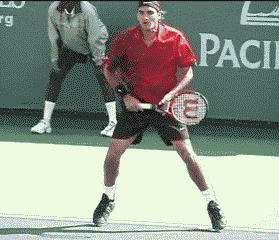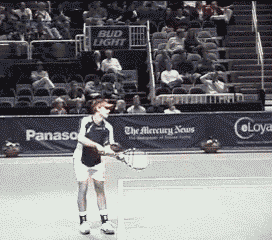|
TennisOne Lessons How Andy Roddick Can Beat Roger Federer Paul Fein The picture could not look bleaker for Andy Roddick and the other contenders and pretenders hoping to dethrone King Roger. Federer has whipped Roddick ten out of 11 times and overpowered Lleyton Hewitt nine matches in a row, and he enjoys a 7-2 career edge over unpredictable Marat Safin. Only teenaged sensation Rafael Nadal, whose forte is clay, has spun an advantage, 2-1, over Federer. “He's probably as close as he has been to unbeatable,” conceded Roddick after losing to the stylish Swiss at Wimbledon for the third consecutive year.
Despite Federer's 6-2, 7-6, 6-4 rout of A-Rod in the 2005 Big W final, Roddick should not be disheartened. If Chris Evert, who lost 13 times in a row to superstar Martina Navratilova in the 1980s, could turn the tide during their long rivalry, so can the world's fastest server who boasts far more firepower. Evert hit the gym to improve her speed, strength and stamina. Roddick has the game, the physical strength, topnotch coaching in Dean Goldfine, and the dedication to turn the lopsided “rivalry” around. His determination is second to none. “I want another crack at him till my record is 1-31,” vows Roddick. “I still want to go against him again.” Here's what this scribe—also a USPTA-certified teaching pro and former top 10-ranked New England men's tournament player—suggests. Move In Closer After standing a horrendous 5 to 10 feet behind the baseline during rallies for the past two years, Roddick positioned himself much better, about 3 feet behind the baseline, during Wimbledon. If he stands even closer, he will play better offensively. He will give Federer less time to react to his shots, his own shots will land deeper, he will get closer to net following approach shots, and he will be able to create sharper angles on his crosscourt shots. Defensively, Roddick will be better positioned to prevent Federer from doing those same offensive things to him as well as being better able to reach drop shots and drop volleys and running far less during the course of a match.
Improved Volley Roddick's improved volley enabled him to win 71 percent (177 out 247) of the points at net during his first six Wimbledon matches. But his effectiveness plunged to only 43 percent (18 of 42) of the points at net during the final. A major reason Federer passed Roddick so often in the final was that Roddick hit far too many crosscourt approach shots. That allowed Federer to either stroke the ball into the open court or crosscourt—his favorite backhand passing shot—back where the moderately agile Roddick had come from. Roddick must aim his approach shots down the line and very deep unless he can hit a winner or a near-winner crosscourt. Goldfine's strategy is to have Roddick keep Federer off balance with a more diversified attack, chiefly coming to net as often as he can. To succeed, however, Roddick must play percentage tennis when net-rushing. That also means Roddick must hit crosscourt volleys very decisively or else Federer will pass him for the same reasons. Roddick also risks getting burned by lobs as well as bullet passing shots if he positions himself too close—within 5 feet of the net. The Serve Roddick holds the world record for the fastest serve (155 miles per hour), but his explosive serve, at least in terms of aces, should be more dominating. Roddick averaged only 4 aces a set (104 aces in 26 sets) on Wimbledon 's slick grass. He smartly kept Federer off balance when he handcuffed Federer with serves into the body to win several points.
I suggest Roddick also hit more serves wide to force Federer to start points from the alley or even outside of it. To confound Federer further, Roddick should continue to serve and volley occasionally, but mostly to Federer's backhand in the ad court. Federer's Backhand Federer's backhand is a “relative” weakness, but it can be exploited only if he is forced to hit it on the dead run and/or against considerable power. To make that happen, Roddick must hit more down-the-line backhands and crosscourt forehands hard and deep to Federer's forehand corner. Yes, Federer boasts a terrific forehand, but that is a calculated risk Roddick has to take to “open up” the backhand side. If the strategy works, Federer will over hit some forehands, and more important, he'll then have to hit backhands on the dead run, which will result in increased forced errors and weak returns. The Short Ball Both players love to run around their backhands to whack big forehands from the backhand half of the court, even doing it from the backhand corner. That ploy works best when those forehands are powerful, deep and well-placed. It backfires most often when the reverse crosscourt forehand aimed at the opponent's backhand corner falls short and lands in the middle of the court. Federer's forehand is most devastating when he pounces on short balls, especially short crosscourt shots. That is why Roddick must hug the baseline and hit more on-the-rise backhands—rather than pinning himself in the forehand corner. Conversely, Roddick should exploit every short ball by Federer exactly the same way. Studying Federer's matches will teach Roddick how the quick and smart Swiss attacks like a rattlesnake killing its prey.
Doubles Finally, Roddick should play doubles as often as possible. Doubles will improve his volleying, reflexes, forward-backward speed and agility, and service return. He'll also have great fun, more than he'll likely have doing wind sprints, plyometrics and pumping iron. And a happy player is a better player. Roddick should take heart and advice from clever Henri Cochet, one of France 's famous “Four Musketeers.” In 1937 Cochet wrote: “How many times does a player considered the weaker beat an opponent of higher reputation! It is because ‘the weaker' has shown himself the more intelligent, the more subtle, the deeper.” Your comments are welcome. Let us know what you think about Paul Fein's article by emailing us here at TennisOne.
Award-winning tennis writer Paul Fein's book, Tennis Confidential: Today's Greatest Players, Matches, and Controversies , published by Brassey's, Inc., was listed No. 1 among tennis books by Amazon.com and BN.com. Information about the book and how to order it can be found at: www.tennisconfidential.com . His second book, You Can Quote Me on That: Greatest Tennis Quips, Insights, and Zingers , was published by Potomac Books, Inc. (formerly Brassey's, Inc.) in February 2005. For more information, visit www.tennisquotes.com |


